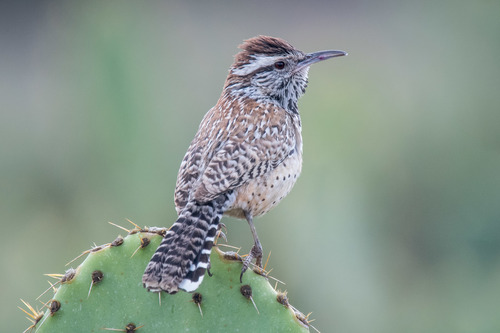
Cactus Wren
The Cactus Wren (*Campylorhynchus brunneicapillus*) is a large, charismatic wren species native to the arid and semi-arid regions of the southwestern United States and Mexico. It is well-known for its distinctive, loud calls and its close association with cacti, particularly cholla and saguaro, which provide nesting sites and protection from predators. As a primarily ground-dwelling bird, it plays a crucial role in its desert ecosystem by dispersing seeds and controlling insect populations. The Cactus Wren is the state bird of Arizona, reflecting its iconic status in the region.
18-22 cm
Length
23-28 cm
Wingspan
Least Concern
Conservation Status
Distribution
The Cactus Wren's range extends from southern California, Nevada, Utah, and parts of Colorado through Arizona, New Mexico, and Texas, and south into central Mexico. They are non-migratory, generally remaining in the same area year-round.
Lifespan
Typically 7-10 years in the wild.
Cactus Wren's Habitat
Habitat Types
Desert scrub, Arid grasslands, Suburban areas with desert landscaping
Climate Zones
Arid, Semi-arid
Adaptations
Cactus Wrens are highly adapted to hot, dry environments. They obtain much of their water from their food and build nests with an entrance tunnel that helps regulate temperature and humidity. They are also known for building multiple nests that provide sleeping places and decoys for predators.
Variations
Several subspecies are recognized, differing slightly in plumage color and size across their geographic range. For example, coastal populations tend to be darker than those in the interior deserts.
Appearance
Breeding Plumage
Plumage is similar year-round.
Seasonal Feather Changes
No significant seasonal variations.
Sex Based Plumage Differences
Males and females have similar plumage.
Notable Features
Brown back with heavy white and black spotting, White eyebrow stripe, Long, slightly decurved bill, White underparts with black spotting on the breast and belly, Long tail, often held cocked upward
Diet and Feeding
Primary Foods
Insects, Spiders, Seeds, Fruits, Small lizards (occasionally)
Foraging Behavior
Cactus Wrens primarily forage on the ground, probing under rocks and vegetation with their bills. They also glean insects from cacti and other plants. They are known to be opportunistic feeders.
Specializations
Their slightly decurved bill is well-suited for probing into crevices and under bark. They are also adept at handling spiny insects and avoiding cactus spines.
Seasonal Diet Variations
Their diet shifts slightly with the seasons. During the breeding season, insects form a larger portion of their diet, while seeds and fruits become more important in the fall and winter.
Behavior
Social Structure
Cactus Wrens are typically found in pairs or family groups. They are not highly social outside of the breeding season, but family groups may remain together for some time.
Communication
A harsh, rasping call often described as 'churr-churr', A series of rapid, descending notes, Males sing to defend territory and attract mates
Migration
Non-migratory; resident within their range.
Territorial or Group Behaviors
Cactus Wrens are highly territorial, defending their nesting and foraging areas from other wrens and potential predators. They are known for their bold and aggressive behavior.
Conservation
Threats
Habitat loss due to urbanization and agriculture, Pesticide use, Predation by domestic cats
Protection Programs
Habitat preservation efforts in some areas, Public awareness campaigns promoting responsible pet ownership
Local National Laws
Protected under the Migratory Bird Treaty Act in the United States.
Population Trend
Stable
Population Estimates
Not Evaluated
Interesting Facts
Cactus Wrens often build multiple nests.
These extra nests are used for roosting and as decoys to confuse predators.
They can tolerate very high temperatures.
They are well-adapted to the extreme heat of their desert habitat.
They are known to reuse nests from previous years.
This saves time and energy, especially in areas where nesting materials may be scarce.
Cactus wrens are known to have a mutualistic relationship with some cactus species.
By nesting in the cacti, the birds gain protection, and the cacti may benefit from seed dispersal and pest control by the wrens.
Faqs about Cactus Wren
What do Cactus Wrens eat?
They eat a variety of insects, spiders, seeds, fruits, and occasionally small lizards.
Where do Cactus Wrens live?
They live in desert and arid regions of the southwestern United States and Mexico.
Are Cactus Wrens migratory?
No, they are non-migratory and remain in the same area year-round.
How can I attract Cactus Wrens to my yard?
Provide native desert vegetation, especially cacti, and a source of water. Avoid using pesticides.
Are Cactus Wrens endangered
No. Cactus Wrens are listed as 'Least Concern' by the International Union for Conservation of Nature (IUCN).
Copyright @ Nature Style Limited. All Rights Reserved.
 English
English